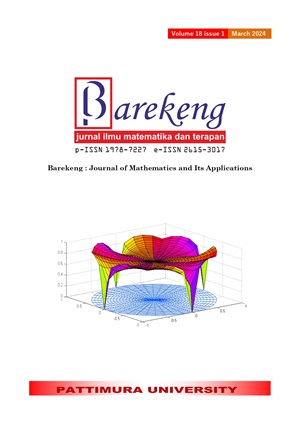DYNAMIC SYSTEM OF TUBERCULOSIS MODEL USING OPTIMAL CONTROL IN SEMARANG CITY INDONESIA
Abstract
Tuberculosis is a disease which is very contagious among human. To prevent this from happening, Semarang city government has enacted vaccination for exposed individuals and treatment for the infected individuals. Vaccination and treatment are forms of control that will be applied to dynamic model systems of Tuberculosis. The present paper will describe epidemic model of Tuberculosis with control using Pontryagin Minimum Principle to find optimal solution of the control with fixed time and free end point. The optimal control will aim to reduce or minimize the number of infected populations. Numerical calculation is carried out with MATLAB software programming to illustrate and compare the graph of the dynamic model with and without optimal control. The results of dynamic modeling of Tuberculosis with control state that vaccination and treatment have succeeded in reducing the population of infected individuals.
Downloads
References
D. Kereyu and S. Demie, “Transmission dynamics model of Tuberculosis with optimal control strategies in Haramaya district, Ethiopia,” Advances in Difference Equations, vol. 2021, no. 1, Jun. 2021, doi: https://doi.org/10.1186/s13662-021-03448-z.
O. Sharomi and T. Malik, “Optimal control in epidemiology,” Annals of Operations Research, vol. 251, no. 1–2, pp. 55–71, Mar. 2015, doi: https://doi.org/10.1007/s10479-015-1834-4.
Fatmawati and H. Tasman, “An Optimal Treatment Control of TB-HIV Coinfection,” International Journal of Mathematics and Mathematical Sciences, vol. 2016, pp. 1–11, Jan. 2016, doi: https://doi.org/10.1155/2016/8261208.
Dhiraj Kumar Das and T. K. Kar, “Global dynamics of a tuberculosis model with sensitivity of the smear microscopy,” Chaos, Solitons & Fractals, vol. 146, pp. 110879–110879, May 2021, doi: https://doi.org/10.1016/j.chaos.2021.110879.
A. G. Lambura, G. G. Mwanga, L. Luboobi, and D. Kuznetsov, “Modeling the Effects of Helminth Infection on the Transmission Dynamics of Mycobacterium tuberculosis under Optimal Control Strategies,” Computational and Mathematical Methods in Medicine, vol. 2020, pp. 1–21, Nov. 2020, doi: https://doi.org/10.1155/2020/8869377.
R. Fukunaga, P. Glaziou, J. B. Harris, A. Date, K. Floyd, and T. Kasaeva, “Epidemiology of Tuberculosis and Progress Toward Meeting Global Targets — Worldwide, 2019,” Morbidity and Mortality Weekly Report, vol. 70, no. 12, pp. 427–430, Mar. 2021, doi: https://doi.org/10.15585/mmwr.mm7012a4.
C. Wang et al., “Screening and identification of four serum miRNAs as novel potential biomarkers for cured pulmonary
tuberculosis,” Tuberculosis, vol. 108, pp. 26–34, Jan. 2018, doi: https://doi.org/10.1016/j.tube.2017.08.010.
N. Aguilo et al., “Pulmonary but Not Subcutaneous Delivery of BCG Vaccine Confers Protection to Tuberculosis-Susceptible Mice by an Interleukin 17–Dependent Mechanism,” vol. 213, no. 5, pp. 831–839, Mar. 2016, doi: https://doi.org/10.1093/infdis/jiv503.
Y. Cai et al., “Modelling the effects of the contaminated environments on tuberculosis in Jiangsu, China,” Journal of Theoretical Biology, vol. 508, pp. 110453–110453, Jan. 2021, doi: https://doi.org/10.1016/j.jtbi.2020.110453.
Z. Zhang, W. Zhang, K. S. Nisar, N. Gul, A. Zeb, and V. Vijayakumar, “Dynamical aspects of a tuberculosis transmission model incorporating vaccination and time delay,” Alexandria Engineering Journal, vol. 66, pp. 287–300, Mar. 2023, doi: https://doi.org/10.1016/j.aej.2022.11.010.
“Badan Pusat Statistik Kota Semarang,” semarangkota.bps.go.id. https://semarangkota.bps.go.id (accessed Feb. 07, 2019).
dinkes, “Dinas Kesehatan Provinsi Jawa Tengah – Sehat Sejahtera.” https://dinkesjatengprov.go.id (accessed Feb. 15, 2019)
D. K. Das, S. Khajanchi, and T. K. Kar, “The impact of the media awareness and optimal strategy on the prevalence of tuberculosis,” Applied Mathematics and Computation, vol. 366, p. 124732, Feb. 2020, doi: https://doi.org/10.1016/j.amc.2019.124732.
H. Klee and R. Allen, Simulation of Dynamic Systems with MATLAB® and Simulink®. CRC Press, 2018.
Alain Vande Wouwer, Philippe Saucez, C. Vilas, and Springerlink (Online Service, Simulation of ODE/PDE Models with MATLAB®, OCTAVE and SCILAB : Scientific and Engineering Applications. Cham: Springer International Publishing, 2014.
Y. D. Mahardika, “Dynamical Modeling of COVID-19 and Use of Optimal Control to Reduce the Infected Population and Minimize the Cost of Vaccination and Treatment,” ComTech: Computer, Mathematics and Engineering Applications, vol. 12, no. 2, pp. 65–73, Nov. 2021, doi: https://doi.org/10.21512/comtech.v12i2.6466.
Copyright (c) 2024 Dhimas Mahardika, Sopia Kartika

This work is licensed under a Creative Commons Attribution-ShareAlike 4.0 International License.
Authors who publish with this Journal agree to the following terms:
- Author retain copyright and grant the journal right of first publication with the work simultaneously licensed under a creative commons attribution license that allow others to share the work within an acknowledgement of the work’s authorship and initial publication of this journal.
- Authors are able to enter into separate, additional contractual arrangement for the non-exclusive distribution of the journal’s published version of the work (e.g. acknowledgement of its initial publication in this journal).
- Authors are permitted and encouraged to post their work online (e.g. in institutional repositories or on their websites) prior to and during the submission process, as it can lead to productive exchanges, as well as earlier and greater citation of published works.






1.gif)



